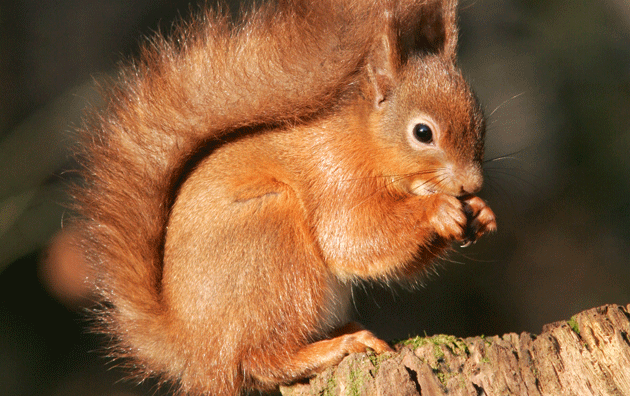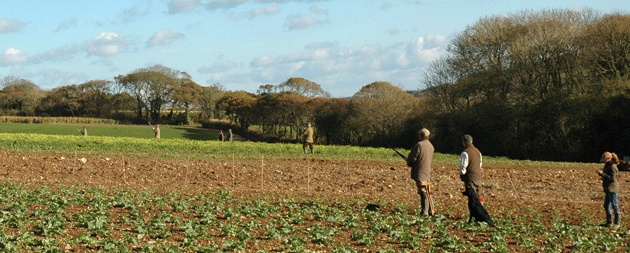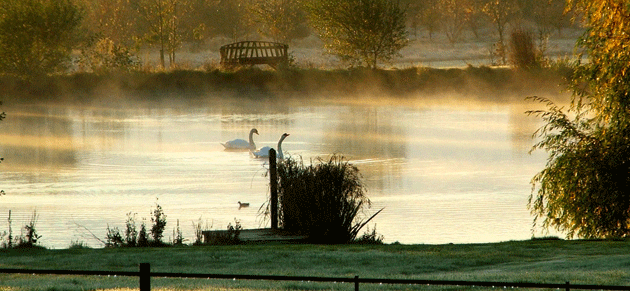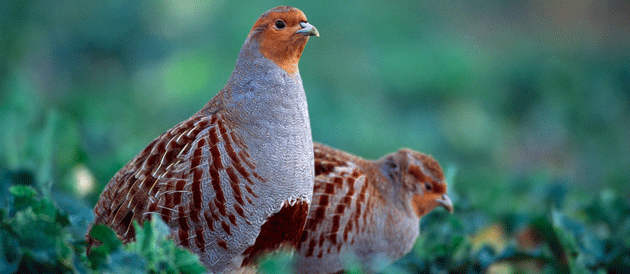Win CENS ProFlex DX5 earplugs worth £1,149 – enter here
Conservation in action
Small shoot owners know that the benefits of a wildlife-friendly shoot stretch far beyond shooting
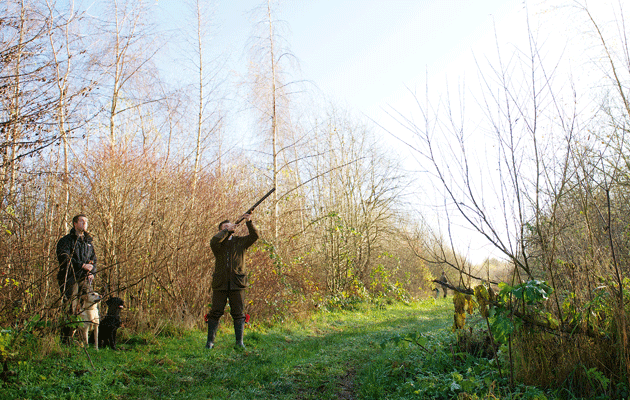
In spite of what the antis might think or say, creating a game-friendly environment enriches the countryside to the benefit of all creatures great and small. It is not done with the sole intention of improving the land’s sporting potential – take a look at the five case studies here and you will see that the motivations stem from a desire to make the countryside a better place for all flora and fauna.
What’s really amazing are the results that can be achieved in such a short space of time, even just by planting a few trees here, or maybe digging a pond over there. Two of the farms highlighted — one a walked-up shoot in Essex, the other a high bird shoot in Devon — were relative wildlife wildernesses before their respective owners embarked on conservation works. Both are remarkable in what they have created. But then, so too are all the others.
Westcroft shoot
Near Newhaven, Cumbria. Former finalist in the Purdey Awards for Game and Conservation.
Size: 52 acres.
Farming: Ten acres of cereal, stubbles are left to encourage the retention of English partridges.
General habitat: Moor, moss land and woods.
Conservation work: Tree planting, new hedgerows, creation of three ponds and an English partridge release scheme.
Species to benefit most: Songbirds, grey partridges, hen harriers, red squirrels, water voles, wildfowl and otters.
Helping hand? Yes — through the Higher Level Stewardship scheme (HLS).
The conservation work carried out at Westcroft, Cumbria, is a labour of love for pest controller and keen Shot Gordon Thomson.
Gordon got to know this patch intimately over the many years he shot it, so when it came up for sale in 2002 he bought it without hesitation. As soon as the deal was done, he began turning the pocket of land with its eco- important 16-acre moss into a wildlife paradise. Gordon has spent his own money but he doesn’t begrudge a penny of it. Recently he qualified for a Higher Level Stewardship grant from Natural England (NE).
Gordon has planted more than 3,000 mixed trees (including 500 hazelnut for red squirrels), 250 yards of hedgerow, and dug three ponds. Hen harriers overwinter on the moss, water voles have colonised the ponds, otters have taken up residence and several pairs of English partridges from the 80 he releases each year stay to breed. He also rears pheasants under bantams, which, he says, fly better than those raised by hand.
He organises four pheasant shoots a season, which yield 20 to 30 head, and up to six evening flights.
Working on the shoot, enjoying small days and watching the wildlife brings Gordon all the satisfaction he needs, but he admits to feeling really proud of having reached the finals of the Purdey Award for Game and Conservation in 2010. “It was nice to get the recognition for the work we’ve done here — and just to get beaten by the Duke of Norfolk with all his acres says a lot, doesn’t it!”
Gordon’s tip:
No doubt about it: vermin control is absolutely vital to creating a wildlife-rich habitat such as this. You have got to keep on top of foxes, carrion crows and rats.
Hendra Farm shoot
Near Truro, Cornwall. Nominated twice in the past five years for the Purdey Award for Game and Conservation.
Size: 300 acres.
Farming: Grazing — cattle and sheep.
General habitat: Mainly grass with a mix of woodland and marsh wetland.
Conservation work: Tree planting and creation of additional marshes.
Species to benefit: Migratory snipe and woodcock. Numbers have increased noticeably.
Helping hand? The Game & Wildlife Conservation Trust’s advisory team gave valuable advice. Grant aid through the HLS scheme.
Conservation work on the Hendra Farm shoot in Cornwall has been ongoing pretty much since master joiner Ken Evans bought the farm and shooting rights in 2000. He and his brothers Mike and Robert planted covercrops and woodlands with the intention of turning Hendra into a high pheasant shoot that matches anything in the West Country.
But the habitat improvements didn’t stop at that — the brothers (and shoot syndicate) have also created purpose-built ponds for teal and mallard. With grant aid through the Higher Level Stewardship the team was also able to create additional marshland for snipe and woodcock. It now draws them in sufficient numbers to warrant driving them, adding to the variety of a day’s shooting.
“All the hard work put into conservation measures here by the team and syndicate to improve the habitat for these waders has paid off, but it has also benefited and attracted many other animals, birds and insects along the way,” says one of the shoot organisers, Rob Baker.
He points out that conservation involves more than just pitching in at weekends. “The whole thing needs to involve the wider community so that there’s an understanding of what is being done, and why. It’s the best way to promote shooting.”
Rob’s tip: Grant allocation for this kind of conservation work is changing all the time so it really does pay to have someone on board who knows what’s happening and can target the application accordingly.
Ulting Hall shoot
Maldon, Essex, owned by Nigel Musto. Finalist in the 2012 Purdey Awards for Game and Conservation.
Size: 180 acres, 80 of which are arable. Conservation schemes occupy the rest.
Habitat: Open farmland alongside the river Chelmer.
Conservation work: Hedge planting, creation of beetle banks to support English grey partridges and formation of a grazed flood meadow.
Species to benefit most: Grey partridges, snipe, teal and pheasants.
Helping Hand? GWCT advisor Martin Tickler, along with wildlife conservation consultant Simon Breasley, gave advice. Grant aid through the HLS.
Nigel Musto and the Ulting Hall shoot prove that it’s possible to create a wildlife-rich environment from game-barren land. It was, as Nigel says, an “arable wasteland made up of featureless 30-acre fields.”
That was until he and two local farmers sought advice on how to make the site more wildlife-friendly. Nigel and friends went on to create a water meadow alongside the river Chelmer, with a sluice gate to allow flooding to an optimum depth of 9in, beetle banks edged with grass headlands, and 1km of new hedgerows. The flood meadow proved a success and now, on shoot days, it’s not unusual to see upwards of 40 snipe take to the air. Grey partridge numbers are rising, as are wild pheasant numbers thanks to a “cocks only” policy. There are six walked-up days per season with an average mixed bag of 40. Underpinning everything is constant vermin control.
“You only need a pair of foxes working either side of a beetle bank at the wrong time of year and you will lose everything. Stoats, too, can do a lot of damage left to their own devices,” says Nigel, who laid vermin control tracks to make the task easier.
Nigel’s tip: Planning took a year before we approached Natural England because we wanted to see a whole year through before we made any hard decisions. We actually started work on it before we got NE to buy in, which I think helped get it on board as it could see there was real commitment on our part.
Grange Farm Estates shoot
Godington, Oxon, run by Nigel Oakey. A finalist in the 2012 Purdey Award for Game and Conservation.
Size: 540 acres over two farms. 400 pheasants are released on each farm to give seven days’ shooting. The average bag is 50.
Farming: Arable and cattle.
Habitat: Farmland with spinneys, hedgerows and pastures.
Conservation work: Restoration of old ponds, creation of new ponds, hedge and tree planting, wild bird covers and formation of a water meadow.
Species to benefit most: English grey partridges and wild pheasants, songbirds, aquatic life.
Helping Hand? Advice from the Farming and Wildlife Advisory Group. Aid through ELS and HLS.
No shoot existed at Grange Farm when Nigel Oakey and his wife, Penelope, started farming there in 2000. Nigel’s conservation push started immediately with Entry Level Stewardship (ELS) grass margins, which then led to headlands being planted with nectar-rich wild flowers.
Since then, improvement work has been constant, with an extensive programme of hedge planting (hawthorn and blackthorn) along with the creation of new spinneys planted with oak, maple, hazel and silver birch. Wild bird covers went in around 2004- 2005 and two years later Nigel started a small shoot, releasing a few pheasants.
His land doesn’t lend itself to high birds but by planning drives carefully and placing pegs where birds have reached their maximum speed and optimum height when flying back to the pens, Nigel’s team is able to show some corking pheasants. One of the drives he created involved transplanting mature trees on a bankside, forcing birds to climb after being flushed.
No full-time keeper is employed, but the job of controlling vermin is carried out by both Nigel and a couple of friends.
With six pairs on both farms this spring, Nigel is hopeful about the future of English partridges there, too.
Nigel’s tip: Don’t be tempted to rush the planting of covercrops — soil temperature needs
to be right for whatever is being sown, and make sure the seed bed is as good as you can make it.
Brownstone Manor shoot
Near Yealmpton, South Devon owned and run by Michael Hockin.
Size: 400 acres of grassland, arable farmland, woods and water.
Conservation work: Extensive tree and hedgerow planting, creation of ponds and lakes and the fencing of one of three valleys to form a wildlife-rich nature reserve. The addition of covercrops provides habitat for songbirds and other wildlife.
Species to benefit most: Songbirds, teal, tufted, mallard, wigeon and shelduck. Little grebes and snow buntings are regular visitors.
Helping Hand? No — apart from some Entry Level Stewardship for a time, Michael has planned and carried out the work himself.
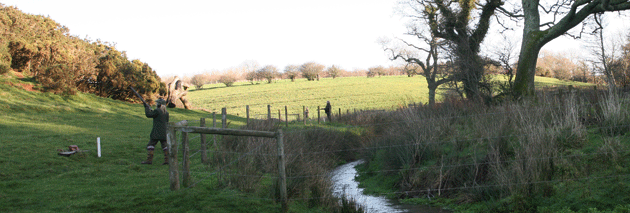
Brownstone has gone from strength to strength since Michael bought it in 1991, when it had just six trees and a noticeable lack of any bird life
Michael Hockin and his wife took on a mountain of work when they bought Brownstone in 1991. “It amounted to a grass and arable valley with just six trees on the place,” he recalls. “There were no birds of any sort.”
However, Michael’s dream of creating his own shoot with a part-time keeper has seen an unbelievable transformation take place. Where once there were six trees, now there are 30,000. There were 12 drives until recently — a new eight- acre wood with covercrops alongside has now been planted and named Diggory’s Drive after an ancestor of Michael’s, who is buried in a nearby graveyard.
“The 12 ponds attract no end of wild duck, which we sometimes shoot once a year. I get a massive amount of pleasure just watching them drop in at flight time. I love to see the shape of their wings as they whiffle down.”
Needless to say, the valley sides and carefully-positioned woods present the Guns with some very challenging birds. “We aim for a bag of 120 or so head, and no more. All are sold to a local restaurant so none are wasted,” says Michael.
Michael’s tip: Keep vermin under control. Left to their own devices magpies, crows and foxes can soon undo a lot of your hard work.
Related Articles
Get the latest news delivered direct to your door
Subscribe to Shooting Times & Country
Discover the ultimate companion for field sports enthusiasts with Shooting Times & Country Magazine, the UK’s leading weekly publication that has been at the forefront of shooting culture since 1882. Subscribers gain access to expert tips, comprehensive gear reviews, seasonal advice and a vibrant community of like-minded shooters.
Save on shop price when you subscribe with weekly issues featuring in-depth articles on gundog training, exclusive member offers and access to the digital back issue library. A Shooting Times & Country subscription is more than a magazine, don’t just read about the countryside; immerse yourself in its most authoritative and engaging publication.






